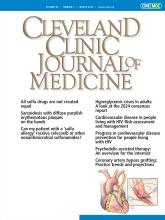
I frequently hear from patients in clinic that they are “allergic to sulfa antibiotics” or have been told to avoid sulfa medications. This concern may be noted in the patient’s electronic medical record (EMR), and various prescribed sulfa-containing medications may be flagged with an avoidance warning in their EMR or by a dispensing pharmacy’s drug database due to concern about cross-reactivity. This chain of events can result in the unnecessary avoidance of useful medications and the prescription of less-effective alternatives. As pointed out by Cline et al1 in this issue of the Journal, there can be significant misinformation leading to a decision to avoid prescribing nonantimicrobial sulfonamides to all patients with a history of “sulfa antibiotic allergy.”
First, is the patient’s history of sulfonamide antibiotic allergy correct? Many patients conflate intolerances like diarrhea or queasiness with allergy. Some patients were told by their parents they had an allergic reaction to an antibiotic taken as a child, without the possibility of further clarification. Others may recall a rash at the time of taking an antibiotic, without a way of retrospectively knowing whether that “rash” was actually caused by the medication or by an underlying (perhaps viral) infection or other triggers. There are no fully validated ways, at present, to definitively diagnose allergy or hypersensitivity to antimicrobial sulfonamides using skin prick tests or in vitro testing.2 Thus, an oral exposure challenge may be needed to confirm the allergy. If the initial presumed “allergy” was a severe hypersensitivity or anaphylactic reaction, this approach is generally avoided.
Allergic reactions to sulfonamide antimicrobials are not unusual. A study using EMR data reported an incidence of approximately 7%,3 and the incidence is believed to be higher in patients with human immunodeficiency virus infection or systemic lupus erythematosus. Of these allergic reactions, most are cutaneous, with maculopapular eruptions being most common (37%), and slightly above 10% are severe.2 Most of these reactions are, at least in part, T-cell mediated and generally delayed in time from the start of therapy. Immediate immunoglobulin E–mediated reactions occur less often.
Critical to the understanding of “sulfa allergy” is, as discussed by Cline et al,1 the fact that sulfa is not the immunologic or allergic target, nor is the sulfonamide molecular moiety that is shared by the sulfonamide antimicrobials and the nonantimicrobial sulfonamides. Distinct nonsulfonamide chemical structures are immunologically targeted, resulting in immediate and delayed hypersensitivity reactions. These structures, while shared among the antimicrobial sulfonamides, are not present in nonantimicrobial sulfonamides like furosemide, probenecid, thiazides, celecoxib, and others.4 Yet antibiotic and nonantibiotic sulfonamides continue to be frequently lumped together, despite a lack of data indicating that they share allergic cross-reactivity. Surprisingly, this includes inconsistent pharmaceutical package insert labeling approved by the US Food and Drug Administration, as discussed by Knowles et al.5
Some patients with a known allergic reaction to an antimicrobial sulfonamide may have an allergic reaction to a nonantimicrobial sulfonamide. This does not prove the case, however, for cross-reactivity and the need for across-the-board avoidance of all sulfonamides in antibiotic-allergic patients. In a conceptually important paper, Strom et al6 reported that some patients have an allergic diathesis—it is not necessarily the drug alone that dictates the likelihood of an allergic response, it may be the patient’s immune system. In their study of 969 patients allergic to an antimicrobial sulfonamide, the risk of an allergic response to chemically dissimilar penicillins (14%) was higher than the risk of an allergic response to nonantimicrobial sulfonamides (9.9%), and both were higher than the usual incidence of allergic reactions to these drugs in patients without an allergic history. And yet some nonantimicrobial sulfonamide drugs carry a warning label suggesting cross-reactivity. As an example, the label for celecoxib indicates that its use is contraindicated in patients with an allergy to antimicrobial sulfonamides, despite the above and the directly relevant data indicating its safe use in 28 patients with history of a “sulfonamide allergy,” including some who tested positive for antimicrobial sulfonamide sensitivity by skin prick or in vitro assay.7 But this can get complicated. For instance, some drugs like sulfasalazine may be metabolized into cross-reactive molecules that are like antimicrobial sulfonamides, and thus should be avoided.8
So while some caution is certainly warranted in patients with a clear allergic history, there is not an absolute need to avoid use of all sulfa-based drugs in all patients with a history of antimicrobial sulfonamide allergy.
Unrelated to the above, I sadly note the passing of John D. Clough, MD, on January 26, 2025. John was a Renaissance man who I was very fortunate to know as my friend, colleague, and mentor. He was nationally known as a clinical researcher and consultant rheumatologist. He chaired the Department of Rheumatology at Cleveland Clinic and then served as the head of Health Affairs. He directly preceded me as Editor in Chief of CCJM from 1996 to 2004, setting in motion several of the successful innovations that continue through today. He was an avid reader, author, musician (euphonium), band conductor, and composer. In his outpatient clinical practice, he presaged the use of the digital medical record. And he was so much more. To his family, parish, and so many friends he was a humble bedrock of strength and equipoise and a moral compass. To those of us who worked with him, it was with utmost respect and admiration that we watched him navigate the corporate waters, never afraid to speak truth to power with a keen analytic mind and a wry sense of humor. Our condolences go out to Mary and family—thank you for sharing John with us.
- Copyright © 2025 The Cleveland Clinic Foundation. All Rights Reserved.






